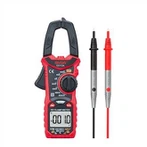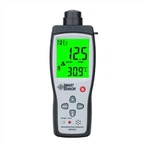Basic Principle of Thermal Anemometer
1. A thin metal wire is placed in a fluid and heated by an electric current to a temperature higher than that of the fluid. Therefore, the metal wire anemometer is called. When the fluid flows through the metal wire in a vertical direction, it will take away some of the heat from the wire, causing the temperature of the wire to decrease.
2. According to the theory of forced convective heat exchange, a relationship can be derived between the dissipated heat Q and the velocity v of the fluid. A standard probe consists of two brackets tensioned with a short and thin metal wire. Metal wires are usually made of metals with high melting points and good ductility, such as platinum, rhodium, tungsten, etc.
3. According to different purposes, the head can also be made into double, triple, diagonal, V-shaped, X-shaped, etc. In order to increase strength, metal film is sometimes used instead of metal wire. Usually, a thin metal film is sprayed on a thermally insulated substrate, which is called a hot film probe. The probe must be calibrated before use.
4. Static calibration is carried out in a specialized standard wind tunnel, measuring the relationship between flow velocity and output voltage and drawing it into a standard curve; Dynamic calibration is performed in a known pulsating flow field, or by adding a pulsating electrical signal to the heating circuit of an anemometer, to verify the frequency response of the anemometer. If the frequency response is poor, corresponding compensation circuits can be used to improve it.
The use of thermal anemometer:
1. Anemometers have a wide range of applications and can be flexibly used in all fields. They are widely used in industries such as power, steel, petrochemicals, and energy conservation. There are also other applications of anemometers in the Beijing Olympics, such as sailing competitions, kayaking competitions, and field shooting competitions, which require anemometers for measurement.
2. There are many industries that require the use of anemometers, and recommended industries include offshore fishing, various fan manufacturing, industries that require exhaust systems, and so on.
3. The working principle of the thermal sensitive probe of an anemometer is based on the cold shock airflow carrying away the heat from the heating element. With the help of an adjustment switch, the temperature is kept constant, and the current and flow rate are proportional to each other.
4. When using a thermal sensitive probe in turbulence, airflow from all directions simultaneously impacts the thermal element, which can affect the accuracy of the measurement results. When measuring in turbulence, the reading of the thermal anemometer flow sensor is often higher than that of the rotary probe.






